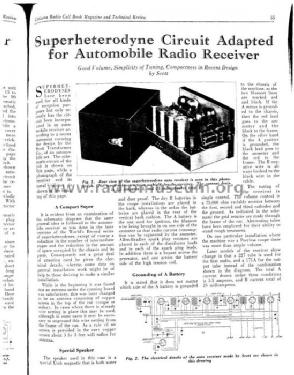Automobile Radio
Scott Radio Labs.(E.H., Transformer); Chicago (IL)
- Country
- United States of America (USA)
- Manufacturer / Brand
- Scott Radio Labs.(E.H., Transformer); Chicago (IL)
- Year
- 1930
- Category
- Car Radio, perhaps also + sound player/recorder
- Radiomuseum.org ID
- 55382
- Number of Tubes
- 7
- Main principle
- Superheterodyne (common)
- Wave bands
- Broadcast only (MW).
- Power type and voltage
- Storage and/or dry batteries
- Loudspeaker
- Permanent or electro-dynamic (moving coil), system not known yet.
- Material
- Metal case
- from Radiomuseum.org
- Model: Automobile Radio - Scott Radio Labs.E.H.,
- Shape
- Chassis only or for «building in»
- Notes
-
tubes are noted only once per type.
In Citizen Radio Callbook, Sept.1930.
- External source of data
- Ernst Erb
- Source of data
- Radio Collector`s Guide 1921-1932
- Mentioned in
- E.H.Scott Radio Collectors Guide (1925-1946)
- Other Models
-
Here you find 201 models, 126 with images and 51 with schematics for wireless sets etc. In French: TSF for Télégraphie sans fil.
All listed radios etc. from Scott Radio Labs.(E.H., Transformer); Chicago (IL)
Forum contributions about this model: Scott Radio Labs.E.H: Automobile Radio
Threads: 1 | Posts: 1
The only reference to auto radios is found in the September, 1930 issue of the Citizen’s Radio Callbook. In a single page article entitled “Superheterodyne Circuit Adapted for Automobile Radio Receiver”, Scott described his automobile radio.
The set is battery operated, obtaining ‘A’ voltage from the ignition battery, and ‘B’ cells in the back. The antenna could be either a copper mesh in the ceiling or a wire hidden in the running board. A small schematic is given, showing the following tubes: two type 27 tubes in the oscillator and second detector, three type 24 tubes for the first detector and two IF stages, a 71A as the first audio stage and a 45 as the final audio. Even using these seven tubes, Scott claimed the set only drew 25mA from the ‘B’ cells. The article leads one to believe that several sets might have been built. The last paragraph states that “later models of the receiver show change in that a 227 tube is used for the first audio, and a 171A for the output instead of the combination shown in the diagram”. The article also mentions that a special water and dust proof
Kent King, 02.Sep.06
